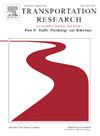Revealing the speeding principle based on the extended theory of planned behavior
IF 3.5
2区 工程技术
Q1 PSYCHOLOGY, APPLIED
Transportation Research Part F-Traffic Psychology and Behaviour
Pub Date : 2025-02-01
DOI:10.1016/j.trf.2025.01.028
引用次数: 0
Abstract
Driver speeding is one of the main causes of deteriorating traffic safety and is a common problem encountered in traffic safety management worldwide. In this study, structural equation modeling of the influencing factors of driver speeding based on the theory of planned behavior (TPB) model is performed to explore the mechanism of highway driver speeding, and the extended factors of driver normlessness, sensation-seeking tendencies, road environment characteristics, and travel scenarios are introduced. The study collected 463 valid samples via a Web survey method. The model results showed that the extended TPB model can explain 79% of the variation in self-reported speeding behavior. Perceptual behavioral control, time-saving benefits, and attitude are the most important influences of speeding intention, with standardized path coefficients of 0.42, 0.36, and 0.32, respectively. Sensation-seeking tendency and normlessness are the next most important factors, with standardized path coefficients of 0.20. The least influential factor is subjective norms, with a standardized path coefficient of 0.19. The environmental dangerousness of roads negatively affects the intention to speed. The optimal scale model results indicated that shoulder width, slope type, and roadside landscape significantly affect perceived dangerousness, in decreasing order of importance. Increased sensation-seeking tendencies not only directly affect the intention to speed but also indirectly affect speeding intention through attitude, and the mediating effect is significant. This study aims to assist transportation researchers in comprehensively understanding the mechanism of driver speeding, allowing them to gain a new vision for investigating ways to regulate driver speeding behavior.
求助全文
约1分钟内获得全文
求助全文
来源期刊
CiteScore
7.60
自引率
14.60%
发文量
239
审稿时长
71 days
期刊介绍:
Transportation Research Part F: Traffic Psychology and Behaviour focuses on the behavioural and psychological aspects of traffic and transport. The aim of the journal is to enhance theory development, improve the quality of empirical studies and to stimulate the application of research findings in practice. TRF provides a focus and a means of communication for the considerable amount of research activities that are now being carried out in this field. The journal provides a forum for transportation researchers, psychologists, ergonomists, engineers and policy-makers with an interest in traffic and transport psychology.

 求助内容:
求助内容: 应助结果提醒方式:
应助结果提醒方式:


